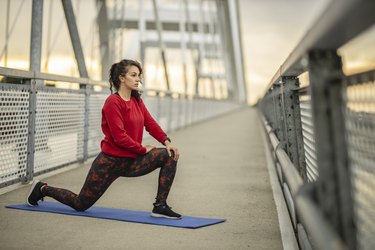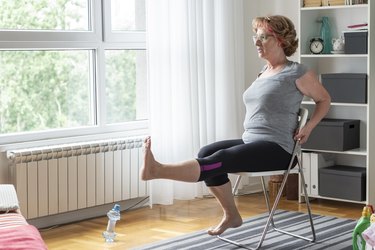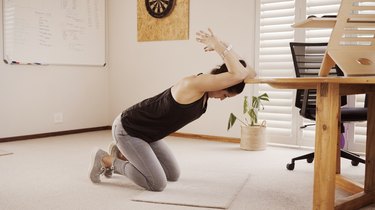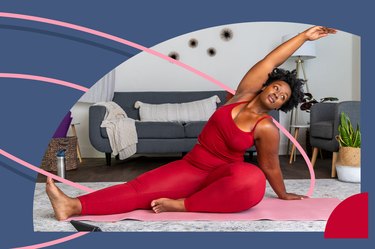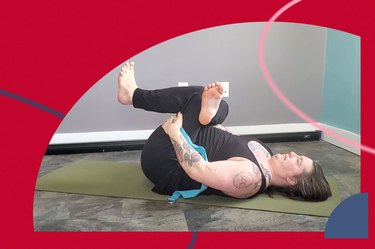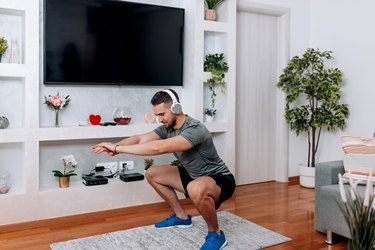
Most experienced exercisers know strength training isn't as simple as lifting a weight up and down. You have to constantly check in on your form, which needs to be on point to keep injury at bay. And you'll want to perform each rep slowly and with control to reap maximum benefits.
Despite all this careful consideration, some lifters still overlook one key aspect of strength training: using your full range of motion. Ahead, learn the benefits of moving through your full range of motion while lifting weights and how to ensure you utilize it.
Video of the Day
Video of the Day
What Does ‘Full Range of Motion’ Mean?
Put simply, range of motion is the extent to which you're able to move a joint, says Grayson Wickham, DPT, CSCS, a physical therapist, strength and conditioning specialist and founder of Movement Vault. Consider the knee: If you were to flex (bend) your knee as far as possible, then extend (straighten) it as far as possible, you're working that joint through its full range of motion, he tells LIVESTRONG.com.
On the flip side, if you move a joint only a fraction of what it's able to do, you're utilizing a partial range of motion. Think about an overhead press: "If someone wasn't bringing the dumbbells fully overhead and their shoulder wasn't fully flexed — even though they're physically able to do that — then they wouldn't be using their full range of motion," Wickham says.
While researchers have determined a "normal" range of motion for each joint, you might not hit those standards; the range of motion you have available all comes down to your current mobility levels, Wickham says. A person with adequate shoulder mobility might be able to lower their chest nearly to the floor during a push-up, while another person who has limited mobility in their shoulders might not be able to lower more than a few inches without triggering compensations in another area of the body, Wickham says.
In the latter instance, it's important to work on improving mobility so, over time, the shoulder joint can move through a greater range of motion. But it's just as important to utilize the entire range of motion that's currently available to you. If the individual with optimal shoulder mobility were to lower only a few inches while doing a push-up (aka a partial rep), negative side effects can arise. And on that note, let's dive into that concept a bit more.
The Importance of Utilizing Your Full Range of Motion
When done on occasion, using a partial range of motion while strength training isn't going to have significant side effects. In fact, partial reps (think: pulses) can help isolate specific muscle groups and increase hypertrophy (increase in muscle size) in targeted areas, which is why they're often used in bodybuilding training programs, says Courtney Roselle, CPT, a certified functional strength coach, level 1 USA Weightlifting Coach and founder of Iron Grace Fitness.
"There are benefits to not moving in a full range of motion, but 90 percent of the time, I'd tell any athlete to use their full range of motion," she tells LIVESTRONG.com. "I would never tell anybody just to do pulsing."
When you perform partial reps consistently, your strength may diminish at the ends of your range of motion. Your muscles are typically weakest at their shortened and elongated positions (like when your elbows are fully flexed and fully extended during a biceps curl) and strongest in the mid-range of motion, Wickham says. But when you neglect to train those end points — by doing biceps curl pulses, for instance — the weak muscles are likely to become even weaker, he adds.
Because partial reps isolate specific muscle groups, they can also lead to muscle imbalances over time, according to Roselle. For instance, a squat performed through the full range of motion (from standing, to knees bent to at least 90 degrees and hips at or below parallel, to standing again) will activate your quads, hamstrings, glutes and hips. But a squat performed just in the mid-range will more heavily target your quads and reduce the workload required by the other muscle groups, she notes.
"[A lot of] injuries happen because one muscle is stronger than the [opposing] muscle," Roselle says. "And when your quad is stronger than your hamstring, you can tear your ACL."
What's more, your body may slowly adapt to that smaller range of motion, and you might lose the ability to sit deep into your squat or extend your shoulder fully overhead, both of which can affect day-to-day functioning.
"[With partial reps], you're going to get strong and really powerful in that short range of motion, if that's your goal," Wickham says. "But eventually, you might lose your full range of motion because you're just not working through it. Your body wants to be as efficient as possible, and if it realizes that you're just not using that range, then you're going to lose it."
That said, you don't want to work past your available range of motion, either.
"You need good hip mobility to do a good squat, and if a person hits their [hips' end range of motion] and tries to go further, another joint is going to have to compensate for that extra range of motion," Wickham says. "In this case, the low back will generally round."
Or, if you try to lower too far into a push-up, your shoulder blades might collapse, Wickham adds. Those mobility limitations and resulting compensations can ultimately lead to injury, like a disc injury in the case of the squat, he says.
That's why working within the full range of motion you currently have available and taking steps to bring your range of motion up to healthy levels — aka improving your mobility — over time is essential, Wickham says.
How to Move Through and Improve Your Full Range of Motion
To boost the odds you work through your available full range of motion in a given exercise, completing a well-designed warm-up is a must. Prioritize active stretches — technically called end-range-of-motion isometrics — in which you stretch out the muscle and then actively contract it.
"You're basically trying to strengthen just at the end range of motion, and that's actually the most effective way to improve your full range of motion," Wickham says.
Choose movements that are specific to the exercises you'll be doing. If you're going to be squatting, for instance, focus on stretches that target your hips and ankles, which help open your range of motion and may help improve your squat depth, Wickham says.
To target your hamstrings, for example, Wickham recommends placing your heel on a bench in front of your body, then pushing your hips back until the muscle is fully stretched. Then, drive your heel and leg down into the bench to contract the muscle and hold for a few seconds.
If you find yourself performing partial reps as you train, consider dropping the weight you're using or switching to a regression that allows you to move through your full range of motion, Roselle suggests.
"As you go heavier, it's going to be harder [to hit your full range of motion] because those end ranges of motion are going to be weaker," Wickham says. Work on building strength and mobility in the affected muscles and joints before progressing back up in load or to the more difficult variation.
Remember, make sure you don't go past your current range of motion while training, and prioritize mobility work elsewhere in your routine, Wickham says. You might spend some time outside of your workouts each week doing 90-90 hip switches to improve your external hip rotation, for example, or wall angels to boost shoulder mobility, along with those active stretches.
Following these tips will help improve your range of motion and, in turn, ensure you get the most out of your workout while minimizing your risk of injury.
